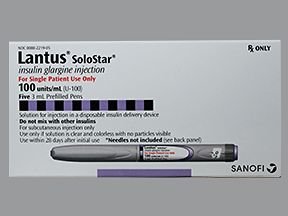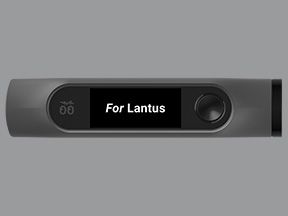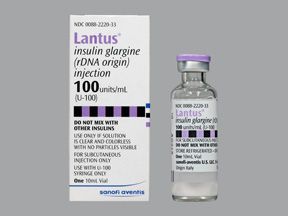Key takeaways
- Lantus is available as a liquid solution in prefilled pens and multiple-use vials. It’s typically injected once daily to manage blood sugar levels in adults and children with diabetes.
- The dosage of Lantus varies depending on whether you have type 1 or type 2 diabetes, your body weight, other medications you take, and other medical conditions you may have.
- It’s important to monitor your blood sugar levels and work with your doctor to adjust your Lantus dosage as needed. You should also be aware of overdose symptoms like low blood sugar.
Lantus is used to help manage blood sugar levels in:
- adults and certain children with type 1 diabetes
- adults with type 2 diabetes
The active ingredient in Lantus is insulin glargine. Lantus belongs to a group of drugs called long-acting insulins.
This article describes the dosages of Lantus, its strength, and how to use it.
The following information describes dosages that are commonly used or recommended. But be sure to take the dosage your doctor prescribes for you. Your doctor will determine the best dosage to fit your needs.
The typical dosage of Lantus your doctor prescribes will depend on whether you have type 1 or type 2 diabetes. If you have questions about the usual dosage of Lantus for your condition, talk with your doctor.
You’ll likely inject Lantus once per day. You can inject it at any time of day, but you should do it at the same time every day.
Lantus forms
Lantus comes as a liquid solution in two forms:
- 3-milliliter (mL) single-use, prefilled injection pens (called Lantus SoloStar pens) that are used with pen needles
- 10-mL multiple-use vials that are used with insulin syringes
Lantus is given as an injection under the skin. Your doctor will show you how to give yourself Lantus injections at home.
Lantus strength
Lantus is available in one strength: 100 units of insulin per mL, which is known as U-100.
If you have type 1 diabetes, your starting dose of Lantus is about one-third of your total daily insulin dose. The rest of this daily insulin total is made up of a fast-acting insulin that you administer at mealtimes. (Fast-acting insulin is prescribed separately by your doctor.)
Your doctor will use weight-based dosing to determine your total daily insulin dose. The usual dosage range for type 1 diabetes is 0.4 to 1 unit of insulin per kilogram (kg) of body weight. (1 kg is about 2.2 pounds.)
For example, a doctor might prescribe 0.5 units per kg daily to a person weighing 66 kg (about 145 pounds). So their total daily insulin would be 33 units. Their Lantus dosage would be one-third of this total, meaning they’d take 11 units of Lantus daily. They would administer the remaining 22 units as a fast-acting insulin with each meal.
If you have questions about your Lantus dosage for type 1 diabetes, talk with your doctor or pharmacist.
If you have type 2 diabetes, your doctor will use weight-based dosing for Lantus. Your initial dose of Lantus will likely be 0.2 units of Lantus for every kg of body weight. The maximum starting dose of Lantus for this use is 10 units per day.
If you have questions about your Lantus dosage for type 2 diabetes, talk with your doctor or pharmacist.
Lantus is used to help manage blood sugar levels in children ages 6 years and older with type 1 diabetes.
The dosage of Lantus for children is the same as that for adults. For details, see the “Dosage for type 1 diabetes” section.
You receive Lantus as an injection under your skin. You can inject it into your abdomen, upper arms, or upper thighs.
You should use a different area of the body each time you give yourself a Lantus injection. You can do this by injecting Lantus at least one finger-width away from your previous injection site. Or you can choose a new area of your body for each Lantus injection.
Avoid injecting Lantus into areas of the skin that are irritated, tender, or bruised.
If you use Lantus SoloStar pens, you’ll need to purchase pen needles. Before injecting each dose of the drug, you’ll attach a new needle to the pen.
If you use Lantus vials, you’ll need to purchase insulin syringes. You’ll use a new insulin syringe for each dose of the drug.
Your doctor will show you how to give yourself injections using the Lantus SoloStar pens or vials. You can also learn how to inject Lantus insulin step-by-step from the manufacturer’s website. Or you can read the prescribing information for Lantus.
Is Lantus used long term?
Yes, Lantus is typically used as a long-term treatment. If you and your doctor determine that Lantus is safe and effective for you, you’ll likely use it long term.
Below are answers to some common questions about Lantus’s dosage.
Can I use Lantus at bedtime? If so, what’s the dosing?
Yes, you can use Lantus at bedtime. But there isn’t a specific dosing at bedtime. You’ll inject the dose that your doctor prescribes for you.
Lantus is typically injected once daily, at any time of day. However, it’s best to inject your dose at the same time every day. This helps keep a steady level of Lantus in your system so that it can work effectively. So if you and your doctor decide that injecting Lantus at bedtime is right for you, you’ll continue to do this throughout your treatment.
If you have questions about the timing of your Lantus dose, talk with your doctor or pharmacist.
Is there a dosing calculator available to help determine what my Lantus dose should be?
There isn’t a specific dosing calculator for Lantus. It’s not usually needed, since your doctor will follow dosing guidelines to determine your Lantus dosage. They may use a dosing calculator to help them do this. But it’s unlikely that you’ll need to determine your own dosage of this drug.
If you have questions about how your Lantus dosage is calculated, talk with your doctor.
If you miss a dose of Lantus, inject your missed dose as soon as you remember. If it’s almost time for your next dose, you can skip the missed dose. Then inject your next dose at your usual time.
If you aren’t sure whether to take a missed dose of Lantus or skip it, talk with your doctor or pharmacist.
If you need help remembering to take your dose of Lantus, try using a medication reminder. This can include setting an alarm or downloading a reminder app on your phone.
The dosage of Lantus you’re prescribed may depend on several factors. These include:
- the type and severity of your diabetes
- the form of Lantus you use
- your body weight
- the amount of carbohydrates you eat
- when and how much you exercise
- other medications you take, including other insulins
- other medical conditions you have
Dosage adjustments
Your doctor will show you how to monitor your blood sugar levels while using Lantus. They’ll explain how to adjust your Lantus dosage based on your blood sugar. For example, if your blood sugar isn’t well-managed, they may increase your dose.
Your doctor may adjust your dosage based on other factors, including those previously listed.
If you have questions about Lantus dosage adjustments, talk with your doctor.
Don’t inject more Lantus than your doctor prescribes. Using more than this can lead to serious side effects.
Symptoms of overdose
Symptoms caused by an overdose can include:
How to recognize and treat low blood sugar
In case of overdose, it’s important to recognize symptoms of low blood sugar and know how to treat it.
Low blood sugar may cause the following symptoms:
If you have low blood sugar, eat at least 15 grams of fast-acting carbohydrates within 15 minutes of your symptoms starting. Examples of fast-acting carbohydrates include hard candies, fruit juice, and regular (not diet) soda.
You can also use glucose in any of the following forms:
- tablet
- gel
- liquid
- powder
In severe cases, your blood sugar could drop so low that it results in a coma or seizures. If this occurs, you may need someone else’s help to treat it. Be sure a family member, caregiver, friend, or co-worker knows how to recognize and treat low blood sugar.
Severely low blood sugar is a medical emergency. If you have symptoms of this condition, you or someone else should immediately call 911 or your local emergency number.
What to do in case you inject too much Lantus
Call your doctor right away if you think you’ve injected too much Lantus. You can also call 800-222-1222 to reach America’s Poison Centers or use its online resource. But if you have severe symptoms, call 911 (or your local emergency number) immediately or go to the nearest emergency room.
Disclaimer: Healthline has made every effort to make certain that all information is factually correct, comprehensive, and up to date. However, this article should not be used as a substitute for the knowledge and expertise of a licensed healthcare professional. You should always consult your doctor or another healthcare professional before taking any medication. The drug information contained herein is subject to change and is not intended to cover all possible uses, directions, precautions, warnings, drug interactions, allergic reactions, or adverse effects. The absence of warnings or other information for a given drug does not indicate that the drug or drug combination is safe, effective, or appropriate for all patients or all specific uses.







